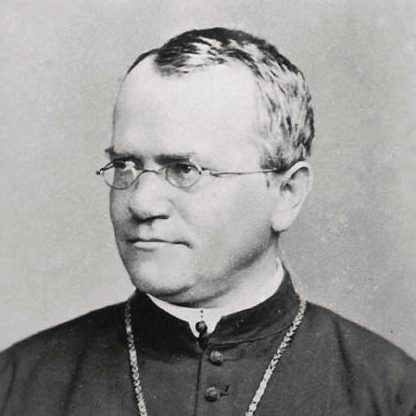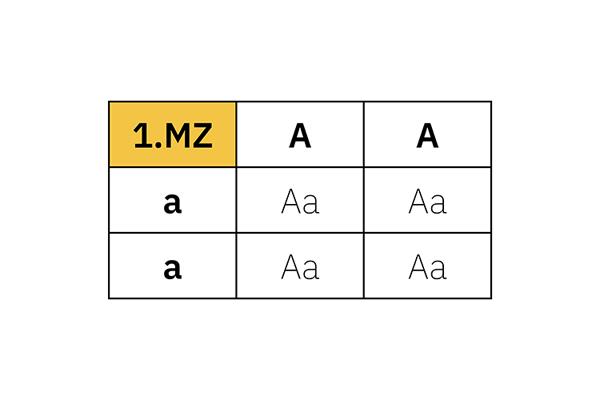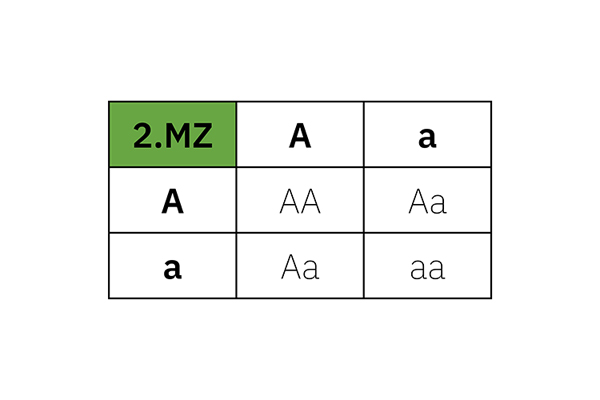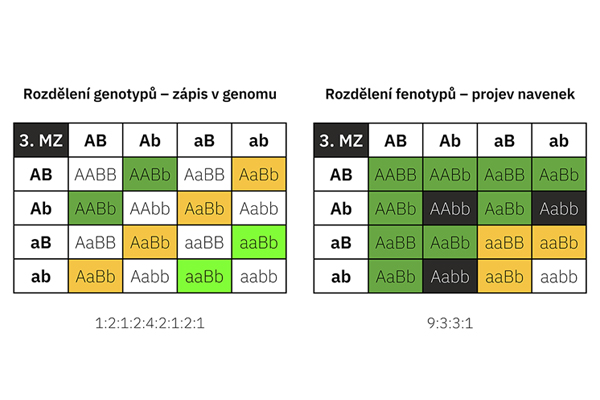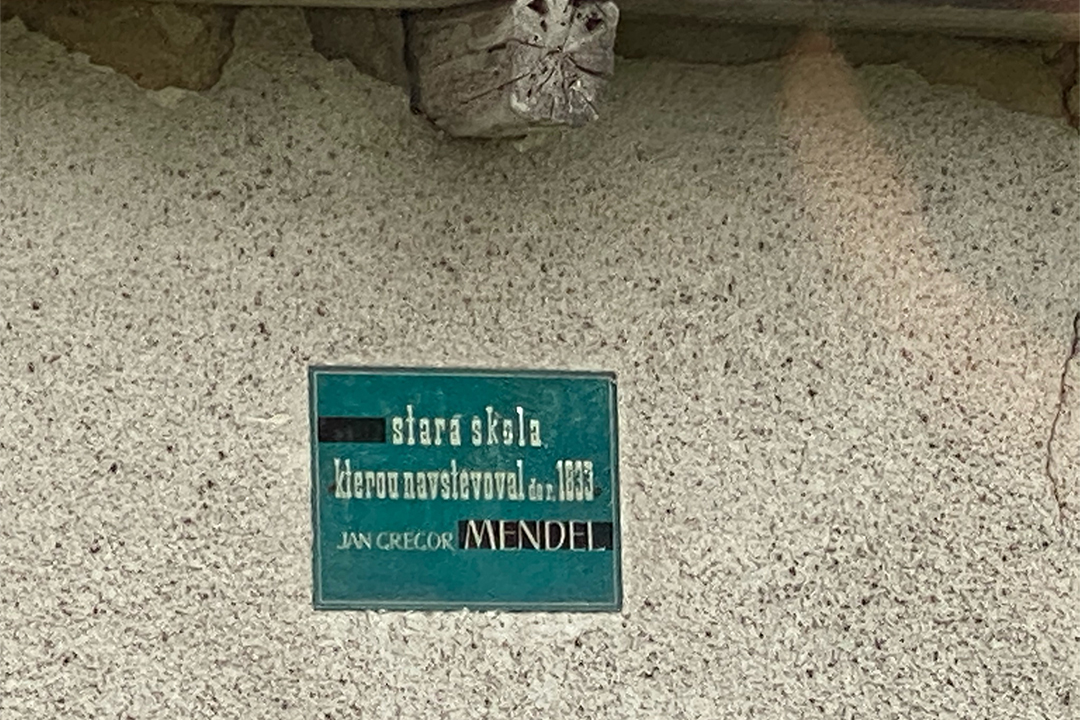In the small village of Hynčice no. 58 (now no. 69) in Lower Silesia of the then Austria-Hungary, part of Kravařsko (Kuhlaendchen), Johann Mendel was born on July 20, 1822. His father Anton Mendel, farmer, veteran of the Napoleonic Wars and mother Rosine, b. The Schwirtlichs already had a two-year-old daughter, Veronika. On July 22, Johann was baptized in the church of St. Peter and Paul in Dolní Vražné, and he always mentioned this day as the date of his birth. Hynčice (Heinzendorf) was inhabited mainly by the German population. Johann Mendel was born into a German family, but he was of about one quarter Czech origin...
1829
Another daughter, Terezia, was born to the Mendels.
1831-1833
Johann attended elementary school in Hynčice, where he was taught by teacher Thomas Makitta and parish priest from Dolní Vražné Jan Schreiber. In addition to basic education, both of them paid special attention to the teaching of natural history, and the school fruit garden with an apiary was used for this. Johann's talent was already evident there.
1833-1834
Johann graduated from the piaristic school in Lipník nad Bečvou, where he demonstrated great theoretical knowledge.
1834-1840
Subsequently, Johann graduated with excellent results from six classes at the gymnasium in Opava. His father was seriously injured while working in the forest in 1838 and could no longer work and support his son in his studies. Johann, as the only son, was supposed to take over the family estate, but decided to continue his studies. His brother-in-law Alois Sturm, Veronika's husband, therefore took over the farm.
In order to continue his studies, Johann completed a course for private teachers in Opava and earned extra money by tutoring. However, severe physical and mental strain caused him to become more seriously ill, so that he had to interrupt his studies from Easter 1839 until autumn. Nevertheless, he advanced to the next class and in August 1840 he finished the gymnasium with the best results.
1840
Johann enrolled at the Philosophical Institute at the University of Olomouc in order to complete his high school education, which was necessary before studying at a university. However, his efforts to find a job remained fruitless, and Johann found himself in an even more serious crisis than in Opava. That's why he returned home for the rest of the year.
1841
He enrolled again to study in Olomouc. This time he found a job and his younger, then thirteen-year-old sister Terezia, who gave up part of her dowry in favor of her brother, made it possible for him to finish his studies.
1843
Mendel's financial affairs continued to be a serious problem, so he discussed his desire to continue his studies with Friedrich Franz, professor of physics at the University of Olomouc. Franz suggested to Mendel to enter the Augustinian Monastery in Brno. Franz, who lived in the monastery for a time, wrote a letter to Abbot František Cyrill Napp (1792-1867) in support of Mendel's candidacy, and Napp accepted Mendel at the end of September. On October 9, he entered the monastery as a novice and took the name Gregor. Since then, only Gregor Mendel signed himself. In the Brno monastery he found an extremely favorable environment for the development of his talent. Abbot Napp took a liking to Mendel from the beginning and created conditions for him to develop his abilities.
1845
Gregor Mendel began his studies at the Faculty of Theology in Brno.
1846
From the time he entered the Brno monastery, Mendel showed an extraordinary interest in the natural sciences. During his studies at the Faculty of Theology, he attended lectures on fruit growing and viticulture with the approval and support of Abbot Nappa. Napp, who wrote a handbook on plant breeding, was also chairman of the Pomological Society and served on the committee of the local Agricultural Society. Professor Franz Diebl, who was known for his articles and books on plant breeding, gave lectures at the Brno Philosophical College.
1847
On August 4, Gregor Mendel was ordained a priest. He continued his studies at the Faculty of Theology and visiting lectures at the philosophy school.
1848
While studying in the fourth year at the Faculty of Theology, he attended supplementary lectures on agriculture at the Brno Philosophical College. In June, Mendel received a certificate of graduation from the faculty, and at the beginning of August he became a chaplain at the hospital on Pekařská street.
1849
Contact with the suffering of the sick, however, had such a strong effect on Mendel that he almost fell ill. The generous abbot Napp again came to his aid and offered him a teaching position at the gymnasium in Znojmo, which Mendel gladly accepted. Thus, on October 7, his career as a teacher began, teaching Greek, Latin, German and mathematics.
1850
Mendel's teaching at the Gymnasium in Znojmo was successful, so after a year of teaching, the school directorate recommended that he take the teacher's exam at the University of Vienna, which would secure him a permanent position. Mendel chose natural history and physics. Mendel failed the exam and was told that he could retake it in one year at the earliest. His physics work was graded positively, but he failed the zoology exam. Mendel was more interested in physics and apparently did not have enough to master the wide range of natural sciences. The reason for the failure was his private preparation without studying at the university. When F. C. Napp was investigating why Mendel did not pass the exam, it was suggested that he be sent to the University of Vienna to study natural sciences.
Mendel returned to Brno from the exam.
1851
Despite the failure of the examination in Vienna, he was called in the spring to substitute lectures on natural sciences at the Brno Technical University for professor Jan Helcelet, who was ill, for two months. Here too he was very successful as a teacher. Abbot F.C. Napp continued to support Mendel in his efforts to achieve further professional education, and so on October 27, Mendel entered the University of Vienna.
1851-1853
During four semesters at the university, Mendel attended lectures in zoology, botany, chemistry, microscopic botany, paleontology, mathematics, and physics. During his studies, he became familiar with combinatorics, which he later used to plan and evaluate his experiments with plant crossing.
1853
He finished his studies in Vienna, and after returning to Brno, he took up a position as a substitute teacher of natural history and physics at the then German Higher Real School in Brno. The school management appreciated his exceptionally good teaching performance.
1854
Mendel was preparing a program of extensive research. He apparently developed the idea for his research work already during his studies at the university. He carried out preliminary experiments, he procured seeds of many (gradually up to 40) varieties of peas. He became a teacher of physics and natural sciences at the Technical College in Brno.
1855
At the beginning of the year, he became a member of the natural science section of the Economic Society in Brno.
1854-1856
He verified the purity of pea varieties - the constancy of their characteristics.
1856
He started hybridization experiments with pea varieties in the monastery garden. In the spring, he applied for university exams a second time. This year he was extremely overloaded with work - in addition to studying and preparing for the exam, he was starting the most difficult stage of his experiments with pea crossing. That is why he fell seriously ill already in January. In May, he went to Vienna to take his exams. During the exam on May 5, he got into an argument with Botany Professor Fenzl and therefore failed. The essence of the disagreement was most likely a difference of opinion on fertilization in higher plants, Fenzl was of the opinion that the embryo arises from a pollen grain. Mendel had a nervous breakdown and had to withdraw from the exam. He returned to Brno sick and apparently his condition was serious, because on May 31, Mendel's father arrived in Brno with his brother. However, failure on the exam did not deter him from further study and research work, and he mainly concentrated on his experiments. Even after the failed exam in Vienna, he continued teaching at the real school in Brno. After that, he did not attempt to repeat the exam and remained a dull teacher until 1868.
1862
He became a member of the Natural History Society in Brno. He started meteorological observations for the Meteorological Institute in Vienna. He carried out meteorological observations with great accuracy until almost the end of his life.
1863
He completed the main part of his experiments with peas.
1864
He processed the results of his experiments with pea crossing and read the manuscript at two meetings of the Natural Science Association in Brno on February 8 and March 8
1866
He published his lecture from the previous year in Brno under the title "Versuche über Pflanzen-Hybriden" (Experiments with plant hybrids), which is a basic work clarifying the principle of heredity. At the very end of the year, Mendel sent a print of his classic work to the famous botanist Nägeli in Munich in anticipation, that she would find his understanding and support in him, thus beginning an extensive correspondence between them for several years.
1868
Gregor Mendel was elected to replace the late F.C. Nappa to the position of abbot of the Augustinian Monastery, he assumed the position on March 30.
1869
He was elected vice-president of the Natural Science Association in Brno, at whose meeting on June 9 he gave a lecture about his experiments with the crossbreeding of hawksbills (Hyeracium). He became a member of the Moravian Beekeeping Association.
1870
He published his work with hawks. He started intensive beekeeping and also cooperated with F. Živanský, mayor of the Moravian Beekeeping Association. Together with Živanský, he participated in a beekeeping convention in Kiel, Germany, in September.
1871
Mendel had an apiary built in the monastery garden and gradually settled it with up to 50 bee colonies. He was elected first deputy mayor of the Moravian Beekeeping Association (until 1873), participated in association meetings, where for several years he provided information about his beekeeping research and observations.
1872
Mendel received the Commander's Cross of the Order of Francis Joseph from the emperor for his merits in church and public functions.
1874
With the approval of a law requiring monasteries to substantially increase their contribution to the religious fund, Mendel's hopeless dispute with the Austrian government began, which dragged on until his death. The dispute cost him a lot of energy and contributed greatly to the deterioration of his health.
1876
Mendel was elected deputy director of the administration of Moravská hypoteční banka (he became its director in 1881).
1883
After catching a cold, he fell ill with nephritis and had to give up public activity. In the summer, he was treated in Rožnov and became very fond of the Wallachian region. However, the disease worsened.
1884
On January 6, Mendel died. He was buried on January 9 at the central cemetery in Brno.
Perhaps he had no idea how significant his discoveries of the three laws of heredity, which became the basis of genetics, were. A modest scientist, patiently crossing a number of plant species, mostly peas, in the garden of the Old Brno monastery, made discoveries from which he deduced laws about the transmission of traits from parents to offspring. He did not live to see the fruits of his hard work recognized. A breakthrough in social understanding and recognition of the primacy of his discoveries occurred only after 1900. Today, the results of his research are applied not only in the breeding of plants and animals, but especially in medicine and in other scientific fields. Genetics also forms the basis for current scientific experiments in cell multiplication or cloning.
Mendel's laws of heredity derive from his scientific work Experiments with plant hybrids, but he is not the author himself. They briefly present to us the essence of heredity - the relationships between previous and following generations and show the essence of Mendel's genius discovery. What do they sound like?
